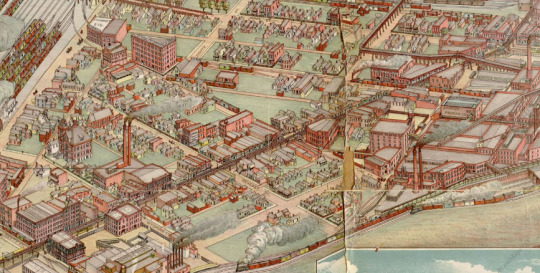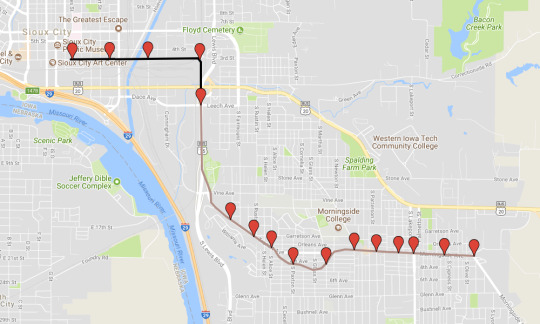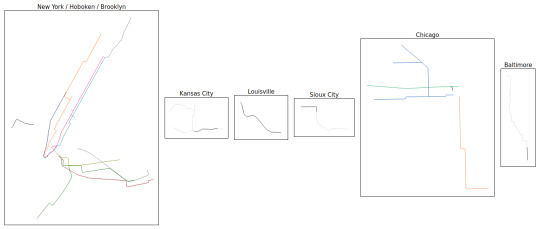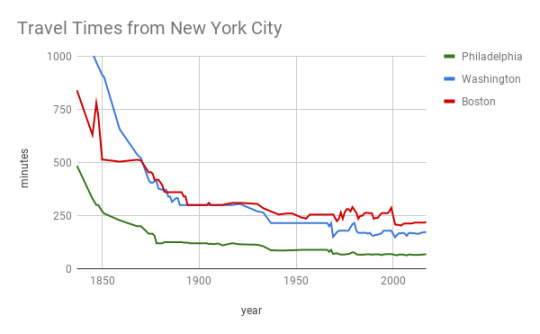Text
Onward Connections
The great Tumblr exodus is nearly upon us; I probably won’t bother posting here after December 17. For trains, transit, and related content, I’m on twitter as @threestationsq (and have always posted much more there than I did here anyway). I’ve also created a dreamwidth as peopleneedaplacetogo in case that turns out to be a good place to argue with the sorts of people I sometimes argue with here; not sure yet how much I’ll use it.
24 notes
·
View notes
Text
Regarding your first question: The program you describe never answers “yes”, it just runs forever if you give it a function that is actually total. Therefore a halting oracle is not sufficient to make the totality problem decidable. (But trying your program on every function does at least give us a way of enumerating all nontotal functions, so the set of total functions is co-enumerable with a halting oracle, or in other words \Pi_2^0.)
Regarding your second question: Turing machines with large finite tapes (like... all the computers we actually have) are finite state machines in principle equivalent to lookup tables so their halting (and totality) behaviour is certainly decideable, but in practice predicting whether a program will halt is still not tractable. Is that also too much of a cheat? A slightly narrower example is “2-symbol Turing machines with no more than 6 states that start with zeroed tapes”; since Busy Beaver of 6 is finite the halting behaviour is certainly decidable (just simulate for BB(6) steps and return “no” if still running) but since Busy Beaver of 6 is not known (and is at least 10^36534) the halting problem for such machines is not tractable.
The universal halting problem, also known (in recursion theory) as totality, is the problem of determining, whether a given computer program will halt for every input (the name totality comes from the equivalent question of whether the computed function is total). This problem is not only undecidable, as the halting problem, but highly undecidable. In terms of the arithmetical hierarchy, it is Π₂⁰-complete (Börger 1989, p. 121).
This means, in particular, that it cannot be decided even with an oracle for the halting problem.
https://en.wikipedia.org/wiki/Halting_problem#Halting_on_all_inputs
I’m surprised, because I thought I’d proven they were equivalent. Given an oracle, you write a program that loops over all possible inputs to your first program and asks the oracle if it terminates on that input. If the answer is no, it stops. Then you ask your oracle whether this program terminates; if the answer is no, the first program terminates on all inputs.
Is that not allowed for some reason?
—
While I’m thinking about this: are there languages which are Turing incomplete, but the halting problem isn’t tractable on them?
You could create the language “brainfuck but if the first byte of its input is 0 it crashes”, but that feels like a cheat.
If you start with a Turing complete language that can only return “yes” or “no”, you could modify it to never halt if it would otherwise return “yes”. But that also feels like a cheat, albeit less so.
Like I’m not convinced you actually lose computational power with those languages, you just have to work around their restrictions.
Is there a non-cheat answer?
17 notes
·
View notes
Text
Problem: NIMBY arsonists.
Getting rid of restrictions on wooden housing in the Bay Area, for the purposes of more carbon sequestration
12 notes
·
View notes
Text
The most obvious constitutional hack is, given a simple majority of both houses of Congress and control of one state government, splitting that state into many tiny states (just as Maine was split from Massachusetts specifically to create two more anti-slavery senators), until you control so many states that amending the Constitution is trivial. (The new states might even just be the personal residences of your most loyal supporters.)
Godel and the Constitution
There’s a famous story that when Godel went for his citizenship interview, he told the examiner (much to the horror of his friends) that he had discovered a flaw in the US Constitution that would allow a dictatorship to be imposed in America.
No record exists of the flaw Godel supposedly discovered. A popular theory is that he noticed that if ¾ of the states agreed, you could amend the constitution to create a dictatorship. But I’m not sure this is what would have worried Godel most, given what had happened in his home country of Austria.
The way Austria became a dictatorship is this: the president of the National Council (analogous to our Speaker of the House) resigned, and then both of his successors resigned, creating a situation where it was unclear what was supposed to happen next. The Austrian Chancellor declared that the parliament had eliminated itself and used this as an excuse to establish a dictatorship.
I wonder if Godel had in mind something similar—a scenario the authors of the Constitution and various amendments failed to account for because they considered it too unlikely. For example, Godel might have worried that if there was ever a breakdown in the presidential succession process, the military might use this as an excuse to take control.
Or maybe Godel was worried about something else—say some obscure provision in the rules for Congressional elections. I’d be really interested in hearing other theories—my Google search results mostly turn up the “constitutional amendment” theory, which I don’t really buy.
10 notes
·
View notes
Text
How can you write this post without even mentioning the high risk of killing someone every time you drive? This whole conversation feels like talking to a member of a race of lizard people who collectively kill and eat 100 people in the US alone every single day, where the lizard person is trying to explain that Soylent Green vs tofu is just a matter of personal preference and so the huge subsidies for Soylent Green production and crushing regulations limiting tofu production are fine.
Theory: long commutes are bad if you spend most of it driving a car. They are not bad if you spend most of it on public transportation.
214 notes
·
View notes
Text
But driving requires constantly modelling and predicting other people's behaviour, and communicating with them nonverbally, and if you mess up at either of these even once then you or somebody else might die! On transit you can just ignore the other people; the fact that you're physically close to them doesn't actually matter at all.
Shitpost-level take: the true divide in this debate is between autistic people and people with ADHD.
If you can’t deal with lots of noise, touch, and people in general, obviously you aren’t going to like public transit.
If you can’t deal with sitting still and putting continuous boring low-level effort into keeping control of something, you’re not going to enjoy driving.
(NB: obviously this is wrong, still a fun idea)
175 notes
·
View notes
Text
(expanding replies into a reblog, with added data)
Lower housing costs aren't anybody's terminal goal, the main reason to care about them instrumentally is that high housing costs keep people from moving to the city and force others to leave. If everybody who wants to can live in the city then mission accomplished, how the prices work out (maybe rents stay high but wages go up? maybe everything else gets cheaper?) is an implementation detail. I support YIMBY because I want all people (or failing that as many people as possible) who want to live in San Francisco (or any other city), from anywhere in the world, to be able to live there. As long as vacant units and second homes are rare (and in cities like SF they are), increasing the number of homes in a city increases the number of people who can live there, which is what I care about.
You equivocate a lot about whether you mean SF proper or the Bay Area. The Bay Area is probably the more relevant unit of analysis, in which case the relevant housing production figures are lower, and e.g. the baseline density is a lot lower. This somewhat janky site lets you get housing permit data by Metropolitan Statistical Area (among other area definitions), and you can get the number of housing units by MSA from factfinder.census.gov. For your convenience, I made a spreadsheet with the data for the metro areas you used in your post. (The Census considers San Francisco and San Jose separate MSAs so I included both.)

As noted in other replies, comparing exclusively to US cities seems odd when most YIMBYs I know think land use policy in the entire US is horribly broken (it's just most noticeable in places like SF). That said other developed countries aren't thaaat different (Tokyo’s housing growth rate is almost 2%, but most European cities are under 1%).
I would find a place like Helena Montana where you have to drive everywhere completely intolerable. It's okay for such places to exist for people who prefer them (or at least, it would be if they paid carbon tax/drove electric cars) but NIMBY laws force almost everybody in the US to live in such places. New York and small parts of San Francisco are exceptions but NIMBYs keep them tightly contained so that only the richest or luckiest have the option of living in them.
Cars kill twice as many people in the US as crime, so I’m not sure BART is the thing to be scared of here; basing claims about its safety on sensationalized anecdotes is at any rate not truth-seeking. The unpleasantness of BART compared to other US transit systems seems to be mostly a consequence of higher homelessness in the Bay Area, which is in turn mostly a consequence of the housing shortage.
I think it makes sense that if somebody who wants to live in a neighborhood with certain characteristics they should be prepared to move if their neighborhood changes around them. Neighborhoods change, and trying to freeze them in amber, stagnant, is often incredibly harmful; it seems almost akin to trying to keep children from growing up. I don’t see why the interests of somebody who happened to get there first should take so much precedence over the interests of the larger numbers of people who want to move in.
Incidentally, I am friends with Alon Levy, their post you linked about "The Mines" was based on stories I told them about my friends in the Bay Area, and after they posted it I showed them your post "To The Great City!" to try to explain why they were wrong about why people move to the Bay Area. (I don’t really understand how you could write that post and then defend denying the rest of us space to move to the Great City too.)
(Also did you seriously outline a rhetorical bingo card about people disagreeing with your position when you're the one who wrote the post about why rhetorical bingo cards are terrible?)
I am writing a steelman of NIMBYs for SSC.
If this is relevant to your interests, can you look at the draft (password is “tumblr”) and let me know if there are any glaring errors?
149 notes
·
View notes
Photo


Havana had elevated trolleys along its waterfront (operating in one direction only, with as far as I can tell just a single elevated station on a ~700m-long structure) from 1904 to 1940. (See http://www.tramz.com/cu/hb/hb.html for more information.)
2 notes
·
View notes
Text
“Successful” seems like an odd term to use here. The housing policy of Bay Area and other US coastal suburbs is extremely successful at its intended purpose, of keeping house prices rising and poor people out. And on the other hand if by “successful” you mean “housing policy that is not a signficant drag on broader economic growth and flourishing” then some of the clearest examples will be places whe the economy is weak for other reasons (Cleveland, Vienna, Montreal, Japan outside the biggest cities, Spain) which are probably not examples to emulate.
That said, housing policies that might be worth trying to learn from:
I used to hear good things about German housing policy. They have a low homeownership rate, strong tenant protections, and housing reportedly depreciated at least as often as it appreciated. That said it sounds like in the past couple years this may be breaking down.
Toronto managed to keep rent growth roughly in line with inflation (2.2% per year 2000-2017) despite significant economic and population growth. This seems largely attributable to the Ontario Municipal Board regularly overriding local land use laws to force local jurisdictions to allow more housing. At the same time Toronto has seen a huge bubble in the purchase price of housing. (Vancouver has also seen purchase prices rise much much faster than rents.) Up to you whether this represents a failure or the best of all worlds. (The OMB was recently abolished so things may get worse in the future.)
Successful non-Japanese housing policy?
(Tum)bleg for information about housing/development policy approaches that have worked besides Tokyo’s. Has anyone else figured out something that works?
32 notes
·
View notes
Photo

Streetcar map of Beijing, c. 1950
3 notes
·
View notes
Text
A poem composed by Jean Loret on the occasion of the introduction of the world’s first urban (land) public transit, the Carosses à Cinq Sols, developed by Blaise Pascal and others in Paris in 1662:
L’établissement des carrosses
Tirés par des chevaux non rosses,
(Mais qui pourront à l’avenir
Par leur travail, le devenir)
A commencé d’aujourd’huy même;
Commodité sans doute extrême,
Et que les bourgeois de Paris,
Considérant le peu de prix
Qu’on donne pour chaque voyage,
Prétendent bien mettre en usage.
Ceux qui voudront plus amplement
Du susdit establissement
Sçavoir au vrai les ordonnances
Circonstances et dépendances,
Les peuvent lire tous les jours
Dans les placards des carrefours
Le dix-huit de mars nostre veine
De écrire ceci prit la peine.
The horse-drawn ‘carrosses’ ran every 7.5 or every 15 minutes (depending on route) on each of five relatively short and winding routes routes around the city, with the overall operation very similar to modern bus services. Google map:

Due in part to getting caught up in politics between the Parlement of Paris & the King (both of whom had initially authorised the service) and in part to the relatively low demand for such a service in the pre-industrial era, operation ceased by the late 1670s. There was then no urban public transit anywhere in the world for nearly 150 years, until the reintroduction of horse-drawn Omnibuses in Nantes (and shortly afterward in Paris) in the 1820s.
2 notes
·
View notes
Photo

Points reachable by nonstop flights from New York City, 1930-2010
2 notes
·
View notes
Text
By 1895 there were eight cities in the US with elevated railway systems. By order of opening date: New York, Brooklyn, Hoboken, Kansas City, Louisville, Sioux City, Chicago, and Baltimore.
I didn't realise how long the Kansas City Elevated was until I saw this view from 1895 last week. It stretched nearly 3km from a tunnel in Kansas City, MO across into Kansas City, KS with at least five elevated stops, and ran through to surface streetcar lines at either end. (One of the stations literally spanned the state line.)


It opened 1886, was electrified 1892, and was mostly torn down fairly early (unclear when but my best guess is in 1904), though a short section with one station remained in use until 1956. Here's a Google map as of 1895 including surface branches (only elevated stations are marked, and there may have been one or two more I don’t know about):

Sioux City's elevated was even shorter-lived. Opened 1891, electrified 1892 (probably first electrified elevated line anywhere in the world), elevated structure abandoned and demolished 1899 (though the surface line feeding it survived as part of the streetcar network). Once again, here’s a Google map:

Unlike the streetcar-fed systems in Kansas City and Sioux City, the Louisville system was essentially frequent local service on a section of mainline railway (with three elevated stations downtown and one on an elevated bridge approach, along with other stops on the surface). Local service ended 1907 but long-distance passenger and freight trains of the B&O, Illinois Central and other railroads continued to use the structure for decades after, I believe until the construction of I-64 in the 1970s severed the line. Google map:

The other five systems from 1895 lasted much longer. The Hoboken and Baltimore elevated lines were integrated into those cities' streetcar networks until demolished and replaced by buses in 1949 and 1950 respectively. (Hoboken’s ran along what’s now Observer Highway up onto the Palisades and then turned onto Central Ave in Jersey City, while Baltimore’s ran along a stretch of Guilford Ave downtown.) The New York (i.e. Manhattan) system was demolished 1940-1955 having been largely (but not entirely) replaced by the subway. Brooklyn's system mostly met a similar fate, but pre-1895 elevated segments remain in use by the J/M/Z trains. And of course Chicago's els are mostly still standing.
Here's a scale comparison of all eight systems as they existed in 1895 (thin lines represent through-running onto streets or other non-grade-separated trackage):

(Outside the US I know of only three other cities that had elevated railways by the definition I’m using by 1895. London had frequent local service on elevated lines out of Charing Cross, Broad St and Fenchurch St stations, and the Liverpool Overhead Railway and Berlin Stadtbahn were also examples. London and Liverpool also already had frequent underground railways, as I believe did Glasgow on the Glasgow City & District. Paris, Sydney, and Melbourne had frequent local steam train service at ground level.)
Recommended links for further reading on the systems mentioned here: New York Hoboken Brooklyn Kansas City Louisville Sioux City Chicago Baltimore
3 notes
·
View notes
Photo

Elevated railway lines proposed by the Boston Rapid Transit Commission of 1892 (source), quite different from what was ultimately built from 1897 onward and even more different from what remains today.
3 notes
·
View notes
Photo

Travel times (by train and/or ferry) from New York to Philadelphia, Washington, and Boston, from the 1830s to present.
2 notes
·
View notes
Video
The continued adventures of Taako, whose very survival is a mystery currently being studied by scientists worldwide.
10K notes
·
View notes
